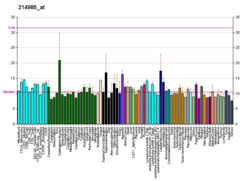Exostosin-1 is a protein that in humans is encoded by the EXT1 gene. [5]
Contents
This gene encodes one of the two endoplasmic reticulum-resident type II transmembrane glycosyltransferase – the other being EXT2 – which are involved in the chain elongation step of heparan sulfate biosynthesis. Mutations in this gene cause the type I form of multiple exostoses. [5]





